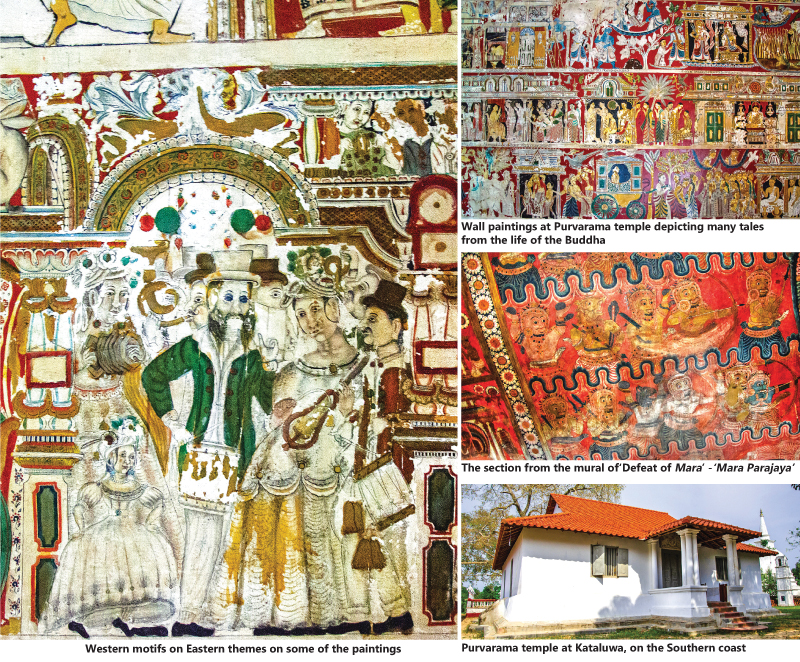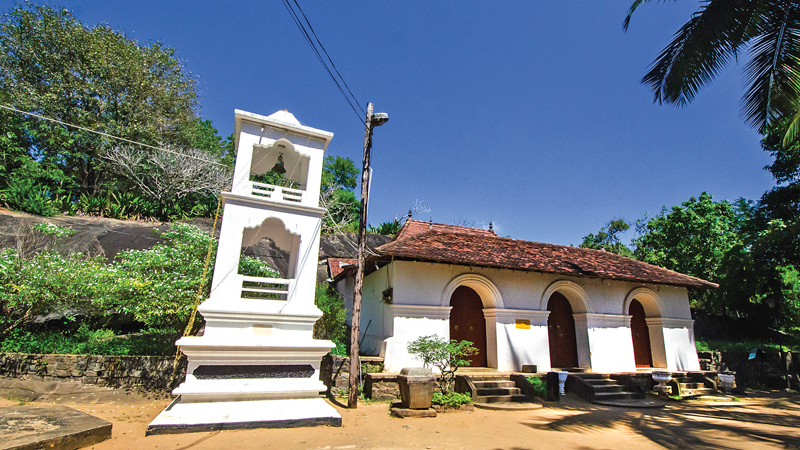Among the murals that have survived the wear and tear of time, wars and invasions, are the notable paintings, in two distinctive styles, of the late medieval period. These comprise the Kandyan-period paintings and their related styles, especially those from the period of the reign of Kirti Sri Rajasingha in the last quarter of the 18th century and secondly, the works from what is roughly termed the Southern School. The latter includes about three different substyles, and dates from the 18th to the last quarter of the 19th centuries
 Sri Lanka has a long and esteemed tradition of sacred, as well as secular paintings, that can be traced back in an almost unbroken line to the pre-Christian era. However, apart from one or two illustrious examples, namely the 1st century BCE murals in the Dambulla rock cave temple, which have been overpainted several times through the centuries, the entrancing 5th century AD frescoes of the Sigiriya rock fortress, and the graceful 12th century AD murals of the Tivanka image house in Polonnaruwa, little of the island’s painting heritage remains from the classical early medieval period.
Sri Lanka has a long and esteemed tradition of sacred, as well as secular paintings, that can be traced back in an almost unbroken line to the pre-Christian era. However, apart from one or two illustrious examples, namely the 1st century BCE murals in the Dambulla rock cave temple, which have been overpainted several times through the centuries, the entrancing 5th century AD frescoes of the Sigiriya rock fortress, and the graceful 12th century AD murals of the Tivanka image house in Polonnaruwa, little of the island’s painting heritage remains from the classical early medieval period.
Among those that have survived the wear and tear of time, wars and invasions, however, are the notable paintings, in two distinctive styles, of the late medieval period. These comprise the Kandyan-period paintings and their related styles, especially those from the period of the reign of Kirti Sri Rajasingha in the last quarter of the 18th century, during which the highland kingdom enjoyed a renaissance in art, culture and religion, and secondly, the works from what is roughly termed the Southern School. The latter includes about three substyles, and dates from the 18th to the last quarter of the 19th centuries.
Paintings from these two periods, in varying degrees of preservation, have survived almost intact mainly in the Buddhist temples of the Kandyan provinces, and their neighbouring areas, and also in about a dozen temples in the Southern maritime province of Sri Lanka.
Degaldoruwa Raja Maha Vihara
A temple in the Kandy district at Gunnepana, established by King Kirti Sri Rajasingha (1747-1780 AD), Degaldoruwa Raja Maha Vihara has large recumbent and seated Buddha statues in a cave shrine. This beautiful cave temple is situated in the village of Degaldoruwa. The site is met with half kilometre along the Yakgahavita road which commences at the Sirimalwatta Ambalama on the Kandy-Lewella Road. The Vihara is on the left of the road.
The paintings belong to the 18th century. The murals in the shrines at Degaldoruwa are some of the best examples of what must be considered the true Kandyan tradition. This is not surprising as the better artists were in the service of the kings and the more affluent chieftains who were resident at the political capital. Dunuwila Mudali carried out the royal commission to construct the shrine. A Dragon arch (Makara thorana) at the entrance to the shrine chamber is flanked by two large figures of guards outside the door.
The paintings are attributed to Devaragampola Silvattena Unnanse, the best known of the ‘sittara’ painters in the Kandyan tradition. These murals are considered the most outstanding examples of this style of paintings. Details of Silawa Jatakaya, Vessantara Jatakaya, Sutasoma Jatakaya (episodes from the Buddha’s many previous reincarnations) and the ‘Defeat of Mara’ are some of the most dramatic compositions. The many compartmented cave temples show the complexity of the lay-out as well as the variety of expression that a completely artistic background has to offer.
Purvarama temple
The murals in the Purvarama temple at Kataluwa near Ahangama, about 130 kilometres from Colombo on the Southern seaboard, are a remarkable manifestation of the scope, content and evolution of indigenous painting at the zenith of British colonial power in 19th century Sri Lanka.
One can only fully comprehend the Kataluwa murals if one views them in their contemporary context. By the time they were painted, Sri Lanka, and especially its maritime provinces, had lived through 350 years of colonial rule by first Portugal, then Holland, and finally, Britain. Inevitably, contemporary artistic metiers and styles were strongly influenced by European standards and values, a trend clearly mirrored in the Kataluwa wall paintings.
Kataluwa murals are over hundred years old. They display the full stylistic range of the Southern school through the greater part of the 19th century. Six Jataka stories are painted on the outer walls of the vestibule: Vessantara. Kattaharvi, Culle Dhammapala, Sutasona, Temiya and Khandehala. Five other stories based on personalities and events in the life of the Buddha – Patacara, Nandiya Upasake, Soreyya Sitano, Masura Sitano and Mahadhanaitano – are some of the paintings. The paintings have the most immediate impact of richness of colour and intricacy of decoration. Like other Sri Lankan wall paintings, these too were meant to be read in several different ways – pictorially, artistically as well as in a moral and religious sense.
Southern styles
The murals of a typical Southern temple and the character and sequence of Southern styles in the latter half of the 19th century are clearly seen in the well-¬preserved paintings at Purvarama.
The original image house dates from the 1840s and initially consisted of only the inner chamber and the vestibule to which were later added the ambulatory corridor and the porch. Soon after the addition, the present paintings had been commissioned. The year 1886 is painted over the front door and a painting is dated 1884. The paintings have a significant stylistic variation with the sectional divisions, which seems to be the result of at least three or more different artists having been at work at the same time.
These murals are not flat or static and have a continuous narration technique. A number of devices is employed to create a sense of space and activity with a background colour of black or red. A picture strip continuity of the narrative is clearly seen throughout. The characters in the stories are deployed very much like actors on a stage, the setting being provided by architectural forms such as palaces, pavilions or outdoor scenes. The image house settings are theatrical with interiors separated into rooms and compartments by columns.





